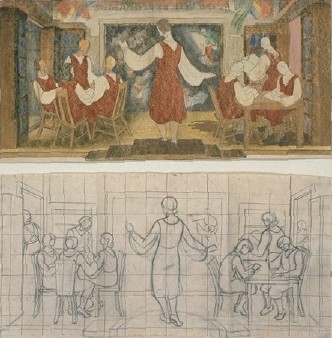|
The Art and Nature of Fresco Main Page Introduction The Feminine & Fresco Creation Choosing a Wall Designing Murals Lime & Sand Plastering Color Painting Gallery Artist Biography Who Owns a Work of Art? Women Muralists Fresco Links Contact Us A Life in Art and Spirituality |
The Art and Nature of Fresco: Introductionby Sr. Lucia Wiley, CHSFresco, in Italian, literally means "fresh," but in the world of art it specifically refers to "fresh or wet plaster." It is simply the name for a medium, or binding material, used in painting, just as oil, water(color), or tempera, are the names for mediums that identify a type of painting. 
In fresco the binding material is calcium carbonate, or lime which is quarried in the form of limestone, burned, and then slaked, meaning that water is added to turn the lime into lime plaster. This lime-water mixture becomes calcium hydroxide plaster which during its drying process has color-binding properties. The process which occurs is two-fold. The calcium hydroxide gives off water into the air, while at the same time absorbing carbon dioxide from it. This double action forms a thin film of calcium carbonate (the same chemical creating the limestone with which we started) upon the surface of the plaster. The color or pigment, if applied before this change occurs, is locked underneath this lime-skin just as if it were sealed in glass. Through a microscope, a piece of fresco looks as if it were made up of millions of tiny pieces of mosaic, each particle of color is separately lodged in place. This simple process -- putting pure color onto wet lime so that a crystalline lime-skin forms over the color as it dries -- has been known for over 10,000 years. All over the world early civilizations, without contact with one another, have painted in fresco. It seems that wherever man built, using sand, lime, and color as his materials, we find fresco. Yet, although the chemical process has always been the same, its development has undergone evolution and it has taken the modern chemist to analyze the process. There are five basic elements to be considered in the creation of a fresco: the structural wall, it's physical home; your design, which reflects the fresco's environment (the architectural setting and the human community in which the fresco will live); lime plaster, which must be prepared to exact standards; sand, which should be of a particular size, shape and composition; and pigment colors, chosen for their beauty, lime-fastness, and longevity. These topics are discussed thoroughly in separate sections, for each element is of critical importance in creating a fresco. image: Sketches for the Youth Marches On frescoes by Lucia Wiley, 1934 image and text © the estate of Lucia Wiley; used by permission |